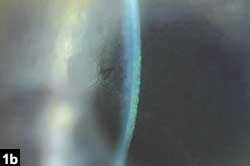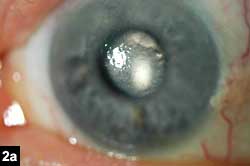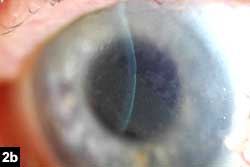Glaucoma patient complains of foreign body sensation, decreased vision
Superficial punctuate keratopathy and keratic precipitates were seen in the cornea of the man’s left eye.

A 70-year-old man with advanced glaucoma presented with a complaint of foreign body sensation, redness, photophobia, tearing and decreased vision in the left eye for the past 2 days.
 Isabel Balderas |  Tom Hsu, MD |
The patient’s ocular history was remarkable for a combined contact extraction with IOL implant and trabeculectomy in the left eye 3 years earlier. Due to increasing IOP, he underwent mitomycin-C needling of the bleb 2 months before presentation. He was then instructed to use topical prednisolone acetate 1% three times daily in the left eye.
About 1 month before presentation, he presented with foreign body sensation in the left eye and was found to have a dendrite on his cornea inferiorly. He was started on Viroptic (trifluridine) eye drops at that time, and the topical prednisolone was reduced to twice daily. The dendrite resolved over 3 weeks on trifluridine, and at follow-up the patient was noted to have a quiet left eye with a functioning bleb and best corrected visual acuity of 20/50. At this visit, the topical prednisolone was discontinued.
The patient’s medical history was remarkable for basal cell carcinoma on the forehead removed by Mohs surgery, colon cancer, hypertension, dyslipidemia and atopic dermatitis. His ocular medications included pilocarpine 1% three times a day in the right eye, Timoptic 0.5% (timolol) once a day in the right eye and Trusopt 2% (dorzolamide) three times a day in the right eye. Systemic medications included acyclovir 400 mg twice a day, baby aspirin, lisinopril and omeprazole.
Examination
The patient’s visual acuity with correction was 20/30 in the right eye and 20/200 in the left eye, with pinhole to 20/70. Pupils, extraocular movements and tonometry were within normal limits. On exam, he was found to have moderate injection of the left eye with an elevated, avascular bleb without leak. The cornea in the left eye had diffuse superficial punctuate keratitis and fine inferior keratic precipitates (Figures 1a-1b). A posterior chamber IOL was seen. Exam in the right eye was notable for trace conjunctival injection and mild diffuse superficial punctate keratitis. Posterior segment exam was unrevealing in both eyes.
At this time, the patient was diagnosed with herpes simplex (HSV) keratouveitis in the left eye. He was started on prednisolone acetate 1% three times daily, trifluridine five times daily, erythromycin ointment twice daily and continued on oral acyclovir. At 1 week follow-up, BCVA was 20/60 in the left eye, and tonometry was 12 mm Hg. His symptoms were improving, and on exam, he had less superficial punctuate keratopathy and keratic precipitates. The bleb appeared elevated and quiet without leakage. The trifluridine was decreased to four times per day, and the prednisolone acetate 1% was decreased to twice daily in the left eye. The right eye was now uninjected and without superficial punctuate keratitis.
One week later, BCVA was 20/100 in the left eye, and tonometry was 13 mm Hg. On exam, there was a line of keratic precipitates extending from the superotemporal limbus to the central cornea. There was also noted to be an area of bullous keratopathy in the superotemporal cornea (Figures 2a-2b). The bleb was quiet and elevated. There was mild flare and rare cell in the anterior chamber. The right eye exam was unremarkable. The prednisolone acetate 1% was increased to three times daily in the left eye at this time.
 |  |
| Color photographs of patient’s right eye and left eye. Note the keratic precipitates inferiorly and the mottled corneal light reflex indicating the presence of edema. | |
 |  |
| Note the band of keratic precipitates extending from the limbus to the central cornea. Also, note the bullous edema in the superotemporal cornea. Images: Tivnan T, CRA, Lahey Clinic | |

What is your diagnosis?
Conjunctival injection with pain
Corneal changes
The differential diagnosis in this patient includes a host of infectious, immunologic and inflammatory entities. Infectious etiologies include HSV, varicella zoster virus, syphilis, Lyme and Acanthamoeba. Immunologic cross-reactions can arise from viral antigens associated with HSV, varicella zoster virus, cytomegalovirus and mumps. Granulomatous inflammation such as sarcoid and mycobacterial tuberculosis can also present like this. Also included in the differential is epithelial downgrowth, postoperative trauma, toxic or chemical injury (eg, 5-flurouracil or mitomycin-C), or peripheral ulcerative keratitis.
The patient was sent for a uveitis consultation, and he was diagnosed with linear endotheliitis after extensive infectious and immunologic studies were obtained. He was treated with acyclovir 400 mg five times daily, prednisolone acetate 1% every two hours in the left eye and oral prednisone 80 mg daily.
Discussion
Linear endotheliitis appears clinically as a line of keratic precipitates on the corneal endothelium that begins near the limbus and progresses centrally and is typically accompanied by peripheral stromal and epithelial edema that follows the advancing line of keratic precipitates. The pathogenesis is unclear, but evidence suggests the mechanism is immunologically mediated. Linear endotheliitis appears clinically similar to allograft rejection after penetrating keratoplasty. Anterior chamber taps of affected eyes reveal lymphocytes, macrophages and endothelial cells.
It is unclear whether an HSV-triggered inflammatory response leads to endothelial cell dysfunction or whether the virus triggers an alteration of antigens expressed on the endothelial surface, rendering it vulnerable to attack by auto-antibodies.
Cases involving uneventful cataract surgery are often associated with inflammation within the wounds and trauma to corneal nerves.
Treatment consists of aggressive administration of topical and systemic corticosteroids and antiviral agents effective against HSV. Prednisone 1 mg/kg orally is used in most cases.
In 1994, Olsen et al published a case series of six eyes of five patients with linear endotheliitis. Additionally, they reviewed a total of 16 eyes of 12 patients from prior published descriptions consistent with this diagnosis. In their study, they used topical dexamethasone and trifluridine every 2 hours and then tapered slowly as improvement was noted. In addition, they advocated the use of acyclovir 200 mg four times daily for prophylaxis.
The patient responded well to treatment, but the cornea in the affected left eye remained edematous. He required a penetrating keratoplasty to improve vision in his left eye. He has done well without recurrence of linear endotheliitis in his graft.
For more information:
- Isabel M. Balderas, MD, and Paul Cotran, MD, can be reached at New England Eye Center, Tufts University School of Medicine, 750 Washington St., Box 450, Boston, MA 02111; 617-636-4219; fax: 617-636-4866; Web site: www.neec.com.
- Edited by Isabel M. Balderas, MD, and Tom Hsu, MD. Drs. Balderas and Hsu can be reached at New England Eye Center, Tufts University School of Medicine, 750 Washington St., Box 450, Boston, MA 02111; 617-636-4219; fax: 617-636-4866; Web site: www.neec.com. Drs. Balderas and Hsu have no direct financial interest in the products mentioned in this article, nor are they paid consultants for any companies mentioned.
References:
- Hakin KN, Dart JK, Sherrard E. Sporadic diffuse corneal endotheliitis. Am J Ophthalmol. 1989;108(5):509-515.
- Khodadoust AA, Attarzadeh A. Presumed autoimmune corneal endotheliopathy. Am J Ophthalmol. 1982;93(6):718-722.
- Olsen TW, Hardten DR, Meiusi RS, Holland EJ. Linear endotheliitis. Am J Ophthalmol. 1994;117(4):468-474.
- Sutcliffe E, Baum J. Acute idiopathic corneal endotheliitis. Ophthalmology. 1984;91(10):1161-1165.
